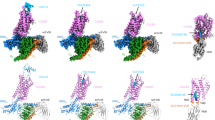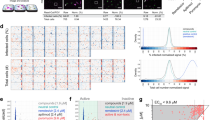Abstract
The bicyclam AMD3100 (formula weight 830) blocks HIV-1 entry and membrane fusion via the CXCR4 co-receptor, but not via CCR5. AMD3100 prevents monoclonal antibody 12G5 from binding to CXCR4, but has no effect on binding of monoclonal antibody 2D7 to CCR5. It also inhibits binding of the CXC-chemokine, SDF-1α, to CXCR4 and subsequent signal transduction, but does not itself cause signaling and has no effect on RANTES signaling via CCR5. Thus, AMD3100 prevents CXCR4 functioning as both a HIV-1 co-receptor and a CXC-chemokine receptor. Development of small molecule inhibitors of HIV-1 entry is feasible.
This is a preview of subscription content, access via your institution
Access options
Subscribe to this journal
Receive 12 print issues and online access
$209.00 per year
only $17.42 per issue
Buy this article
- Purchase on Springer Link
- Instant access to full article PDF
Prices may be subject to local taxes which are calculated during checkout
Similar content being viewed by others
References
Feng, Y., Broder, C.C., Kennedy, P.E. & Berger, E.A. HIV-1 entry cofactor: Functional cDNA cloning of a seven-transmembrane G protein coupled receptor. Science 272, 872–877 (1996).
Bleul, C.C., et al. The lymphocyte chemoattractant SDF-1 is a ligand for LESTR/fusin and blocks HIV-1 entry. Nature 382, 829–833 (1996).
Oberlin, E., et al. The CXC chemokine SDF-1 is the ligand for LESTR/fusin and prevents infection by T-cell-line-adapted HIV-1. Nature 382, 833–835 (1996).
Premack, B.A. & Schall, T.J. Chemokine receptors: Gateways to inflammation and infection. Nature Med. 2, 1174–1178 (1996).
Richman, D.D. & Bozzette, S.A. The impact of the syncytium inducing phenotype of human immunodeficiency virus on disease progression. J. Infect. Dis. 169, 968–974 (1994).
Saag, M.S., Hammer, S.M. & Lange, J.M.A. Pathogenicity and diversity of HIV and implications for clinical management: A review. J. Acquir. Immune Defic. Syndr. 7 (Suppl.2), S2–S11 (1994).
Connor, R.I. & Ho, D.D. Human immunodeficiency virus type 1 variants with increased replication capacity develop during the asymptomatic stage before disease progression. J. Virol. 68, 4400–4408 (1994).
Zhu, T., et al. Genotypic and phenotypic characterization of HIV-1 patients with primary infection. Science 261, 1179–1181 (1993).
Dragic, T. et al. HIV-1 entry into CD4+ cells is mediated by the chemokine receptor CC-CKR-5. Nature 381, 667–673 (1996).
Deng, H.K., et al. Identification of a major co-receptor for primary isolates of HIV-1. Nature 381, 661–666 (1996).
Choe, H. et al. The β-chemokine receptors CCR3 and CCR5 facilitate infection by primary HIV-1 isolates. Cell 86, 1135–1148 (1996).
Doranz, B.J., et al. A dual-tropic, primary HIV-1 isolate that uses fusin and the β-chemokine receptors CKR-5, CKR 3, and CKR-2b as fusion cofactors. Cell 86, 1149–1159 (1996).
Alkhatib, G. et al. CC CKR5: A RANTES, MIP-1α, MIP-1β receptor as a fusion cofactor for macrophage-tropic HIV-1. Science 272, 1955–1958 (1996).
Simmons, G., et al. Primary, syncytium-inducing human immunodeficiency virus type 1 isolates are dual-tropic and most can use either Lestr or CCR5 as coreceptors for virus entry. J. Virol. 70, 8355–8360 (1996).
Connor, R.I., Sheridan, K.E., Ceradini, D., Choe, S. & Landau, N.R. Change in coreceptor use correlates with disease progression in HIV-1 infected individuals. J. Exp. Med. 185, 621–628 (1997).
Arenzana-Seisedos, F., et al. HIV blocked by chemokine antagonist. Nature 383, 400 (1996).
Simmons, G., et al. Potent inhibition of HIV-1 infectivity in macrophages and lymphocytes by a novel CCR5 antagonist. Science 276, 276–279 (1997).
De Clercq, E. et al. Potent and selective inhibition of human immunodeficiency virus (HIV)-I and HIV-2 replication by a class of bicyclams interacting with a viral uncoating event. Proc. Natl. Acad. Sci. USA 89, 5286–5290 (1992).
De Clercq, E. et al. Highly potent and selective inhibition of human immunodeficiency virus by the bicyclam derivative JM3100. Antimicrob. Agents Chemother. 38, 668–674 (1994).
De Vreese, K. et al. The molecular target of bicyclams, potent inhibitors of human immunodeficiency virus replication. J. Virol. 70, 689–696 (1996).
De Vreese, K. et al. The bicyclams, a new class of potent human immunodeficiency virus inhibitors, block viral entry after binding. Antiviral Res. 29, 209–219 (1996).
Chen, B.K., Saksela, K., Andino, R. & Baltimore, D. Distinct modes of human immunodeficiency virus type 1 proviral latency revealed by superinfection of nonproductively infected cell lines with recombinant luciferase-encoding viruses. J. Virol. 68, 654–660 (1994).
Hill, C.M. et al. Envelope glycoproteins from HIV-1, HIV-2, and SIV can use human CCR5 as a cofactor for viral entry and make direct CD4-dependent interactions with this chemokine receptor. J. Virol. 71, 6296–6304 (1997).
Schols, D., Esté, J.A., Henson, G. & De Clercq, E., Bicyclams, a class of potent anti-HIV agents, are targeted at the HIV coreceptor fusin/CXCR4. Antiviral Res. 35, 147–156 (1997).
Litwin, V. et al. Human immunodeficiency virus type 1 membrane fusion mediated by a laboratory-adapted strain and a primary isolate analyzed by resonance energy transfer. J. Virol. 70, 6437–6441 (1996).
Pantaleo, G. et al. Dissociation between syncytia formation and HIV spreading. Suppression of syncytia formation does not necessarily reflect inhibition of HIV infection. Eur. J. Immunol. 21, 1771–1774 (1993).
Layne, S.P., Merges, M.J., Spouge, J.L., Dembo, M. & Nara, P.L. Blocking of human immunodeficiency virus infection depends on cell density and viral stock age. J. Virol. 65, 3293–3300 (1991).
Sylwester, A., Murphy, S., Shutt, D. & Soll, D.R. HIV-induced T cell syncytia are self-perpetuating and the primary cause of T cell death in culture. J. Immunol. 158, 3996–4007 (1997).
Trkola, A. et al. CD4-dependent, antibody sensitive interactions between HIV-1 and its co-receptor CCR5. Nature 384, 184–186 (1996).
Wu, L. et al. CD4 induced interaction of primary HIV-1 gp120 glycoproteins with the chemokine receptor CCR-5. Nature 384, 179–183 (1996).
Moore, J.P. & Sodroski, J. Antibody cross-competition analysis of the human immunodeficiency virus type 1 exterior envelope glycoprotein. J. Virol. 70, 1863–1872 (1996).
Endres, M.J. etal. CD4 independent infection by HIV-2 is mediated byfusin/CXCR4. Cell 87, 745–756 (1996).
Wu, L. et al. Interaction of chemokine receptor CCR5 with its ligands: Multiple domains for HIV-1 gp120 and a single domain for chemokine binding. J. Exp. Med. (in the press).
McKnight, A. et al. Inhibition of human immunodeficiency virus fusion by a monoclonal antibody to a coreceptor (CXCR4) is both cell type and virus strain dependent. J. Virol. 71, 1692–1696 (1997).
Strizki, J.M. et al. A monoclonal antibody (12G5) directed against CXCR-4 inhibits infection with the dual-tropic human immunodeficiency virus type 1 isolate HIV-1 89.6 but not the T-tropic isolate HIV-1 HXB. J. Virol. 71, 5678–5691 (1997).
Lapham, C.K. et al. Evidence for cell-surface association between fusin and the CD4-gp120 complex in human cell lines. Science 274, 602–605 (1996).
Hesselgesser, J. et al. CD4-independent association between HIV-1 gp120 and CXCR4: Functional chemokine receptors are expressed in human neurons. Current Biol. 7, 112–121 (1997).
Picard, L. et al. Role of the amino-terminal extracellular domain of CXCR-4 in human immunodeficiency virus type 1 entry. Virology 231, 105–111 (1997).
Potemya, S. et al. CD4-independent infection by human immunodeficiency virus type 2 strain ROD/B: The role of the N-terminal domain of CXCR-4 in fusion and entry. J. Virol. 71, 4419–4424 (1997).
Brelot, A. et al. Role of the first and third extracellular domains of CXCR-4 in human immunodeficiency virus co-receptor activity. J. Virol. 71, 4744–4751 (1997).
Monteclaro, F.S. & Charo, I.F. The amino-terminal extracellular domain of the MCP-1 receptor, but not the RANTES/MIP-1 α receptor, confers chemokine selectivity. Evidence for a two-step mechanism for MCP-1 receptor activation. J. Biol. Chem. 271, 19084–19092 (1996).
Wells, T.N.C. et al. Selectivity and antagonism of chemokine receptors. J. Leukocyte Biol. 59, 53–60 (1996).
Datema, R. et al. Antiviral efficacy in vivo of the anti-human immunodeficiency virus bicyclam SDZ SID 791 (JM3100), an inhibitor of infectious cell entry. Antimicrob. Agents Chemother. 40, 750–754 (1996).
Liu, R. et al. Homozygous defect in HIV-1 coreceptor accounts for resistance of some multiply-exposed individuals to HIV-1 infection. Cell 86, 367–378 (1996).
Samson, M. et al. Resistance to HIV-1 infection of Caucasian individuals bearing mutant alleles of the CKR5 chemokine receptor gene. Nature 382, 722–725 (1996).
Nagasawa, T. et al. Defects of B-cell lymphopoiesis and bone-marrow myelopoiesis in mice lacking the CXC chemokine PBSF/SDF-1. Nature 382, 635–638 (1996).
Trkola, A. et al. Genetic subtype-independent inhibition of human immunodeficiency virus type 1 replication by CC and CXC chemokines. J. Virol. (in the press).
Koito, A., Stamatatos, L. & Cheng-Mayer, C. Small amino acid changes within the V2 domain can affect the function of a T-cell line tropic human immunodeficiency virus type 1 envelope gp120. Virology 206, 878–884 (1995).
Shibata, R. et al. Isolation and characterization of a syncytium inducing macrophage/T-cell line tropic human immunodeficiency virus type 1 isolate that readily infects chimpanzee cells in vitro and in vivo. J. Virol. 69, 4453–4462 (1995).
Author information
Authors and Affiliations
Rights and permissions
About this article
Cite this article
Donzella, G., Schols, D., Lin, S. et al. AMD3100, a small molecule inhibitor of HIV-1 entry via the CXCR4 co-receptor. Nat Med 4, 72–77 (1998). https://doi.org/10.1038/nm0198-072
Received:
Accepted:
Issue Date:
DOI: https://doi.org/10.1038/nm0198-072
This article is cited by
-
Targeting chemokines for acute lymphoblastic leukemia therapy
Journal of Hematology & Oncology (2021)
-
Microtiter plate-based antibody-competition assay to determine binding affinities and plasma/blood stability of CXCR4 ligands
Scientific Reports (2020)
-
Transient microglial absence assists postmigratory cortical neurons in proper differentiation
Nature Communications (2020)
-
Endosomal escape of protein nanoparticles engineered through humanized histidine-rich peptides
Science China Materials (2020)
-
Gene expression and functional deficits underlie TREM2-knockout microglia responses in human models of Alzheimer’s disease
Nature Communications (2020)



